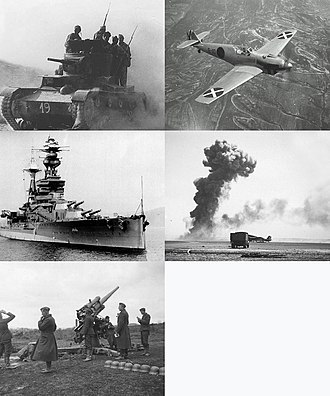Chanchajillan Civil War: Difference between revisions
No edit summary |
No edit summary |
||
| Line 6: | Line 6: | ||
| caption = Clockwise from top-left: members of the XI International Brigade at the [[Battle of Omi (1937)|Battle of Omi]]; Bf 109 with West markings; bombing of an airfield south of [[Ivora]]; Eastern soldiers at the [[Siege of the Vicalvi]]; Western soldiers operating an [[wikipedia:Anti-aircraft warfare|anti-aircraft]] gun; HMS ''Chiaj'' in an incursion around [[Accadia]] on [[Greening Lake]]. | | caption = Clockwise from top-left: members of the XI International Brigade at the [[Battle of Omi (1937)|Battle of Omi]]; Bf 109 with West markings; bombing of an airfield south of [[Ivora]]; Eastern soldiers at the [[Siege of the Vicalvi]]; Western soldiers operating an [[wikipedia:Anti-aircraft warfare|anti-aircraft]] gun; HMS ''Chiaj'' in an incursion around [[Accadia]] on [[Greening Lake]]. | ||
| date = 17 July 1932 – 1 April 1944 <br> 11 years, 8 months, 2 weeks and 1 day | | date = 17 July 1932 – 1 April 1944 <br> 11 years, 8 months, 2 weeks and 1 day | ||
| place = Chanchajilla, | | place = Chanchajilla, Southern [[Paraboca]], Northeastern [[Zamastan]], Northwestern [[Avergnon]] | ||
| result = Eastern Chanchajillan victory | | result = Eastern Chanchajillan victory | ||
* Separation of the [[Greater Chanchajilla]] | * Separation of the [[Greater Chanchajilla]] | ||
Revision as of 02:18, 28 July 2020
| Chanchajillan Civil War | |||||||
|---|---|---|---|---|---|---|---|
 Clockwise from top-left: members of the XI International Brigade at the Battle of Omi; Bf 109 with West markings; bombing of an airfield south of Ivora; Eastern soldiers at the Siege of the Vicalvi; Western soldiers operating an anti-aircraft gun; HMS Chiaj in an incursion around Accadia on Greening Lake. | |||||||
| |||||||
| Belligerents | |||||||
|
|
| ||||||
| Commanders and leaders | |||||||
|
East Chanchajilla Zamastan |
West Chanchajilla Drambenburg Gladysynthia | ||||||
| Casualties and losses | |||||||
| 345,000 killed in action | 390,000 killed in action | ||||||
| 1,500,000–2,000,000 civilians killed | |||||||
The Chanchajillan Civil War was a civil war fought from 1932-1944 between rebel capitalist-republican forces of East Chanchajilla and socialist-anarchist forces of West Chanchajilla. Due to the international political climate at the time, the war had many facets and was variously viewed as class struggle, a war of religion, a struggle between dictatorship and republican democracy, between revolution and counterrevolution, and between fascism and socialism.
The war began after a declaration of military opposition against the socialist controlled government by a group of republican generals of the Chanchajillan Republican Armed Forces, originally under the leadership of Gonzal Jimoth. The government at the time was a coalition of communist and socialist parties, under the leadership of far-left President Manuel Besterio.
The coup was supported by military units in some important cities in the Eastern half of Chanchajilla—such as Vilanja, Mirinu, and Pretesia. This left Chanchajilla militarily and politically divided. The Republicans and the Socialist government fought for control of the country. The Republican forces received munitions, soldiers, and air support from Zamastan, while the socialist side received support from Gladysynthia and Drambenburg. Tens of thousands of citizens from non-interventionist countries directly participated in the conflict. They fought mostly in the pro-Republican International Brigades, which also included several thousand exiles from pro-socialist regimes.
The republican forces of East Chanchajilla officially won the war, which ended in 1944, by achieving their ultimate goal of separating from the Western government and forming their own nation. Once the hostilities ended, the government of West Chanchajilla declared the militarization and hard border separation from the newly organized Eastern government. The war became notable for the passion and political division it inspired and for the many atrocities that occurred, on both sides. The war served as a precursor the the World War.
Organised purges occurred in territory captured by the West's forces so they could consolidate their future regime in their now divided country. Mass executions on a lesser scale also took place in areas controlled by the Republicans, with the participation of local authorities varying from location to location. During the remainder of the 20th and early 21st centuries, several flare ups of violence across the borders of the two nations occurred, including the 1972 Chanchajilla War and the South Turania Offensive (2019).
